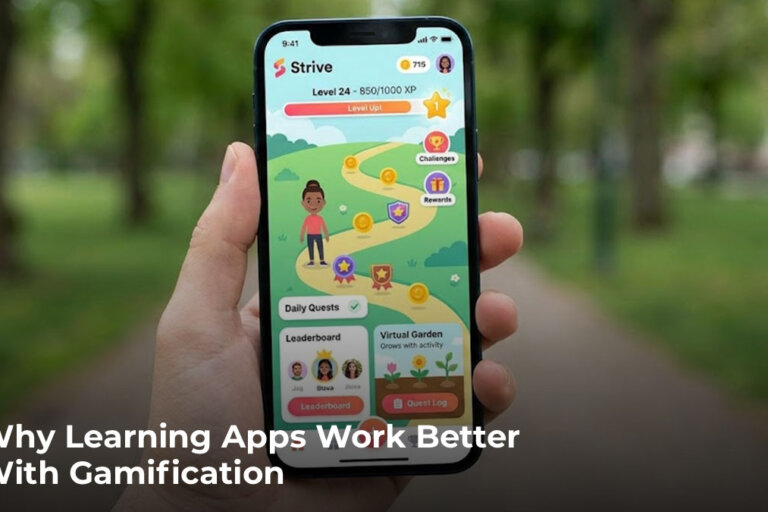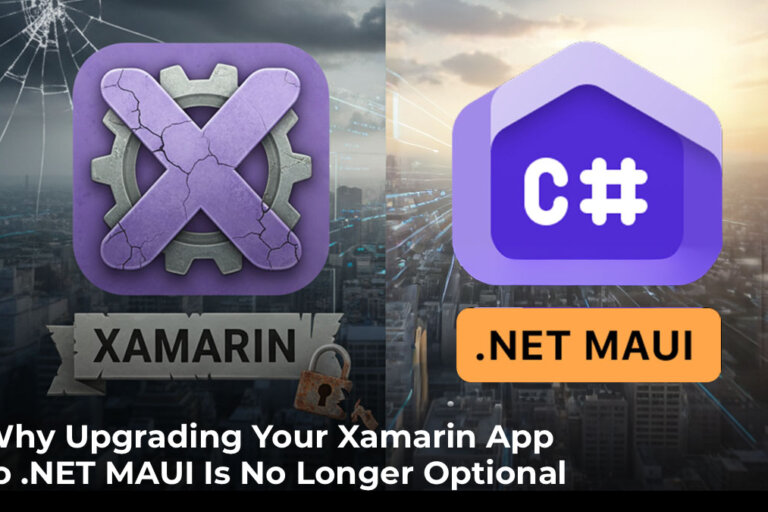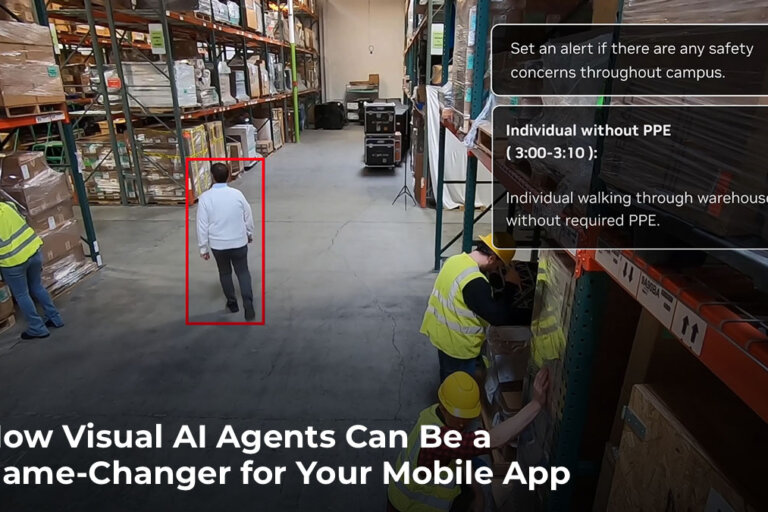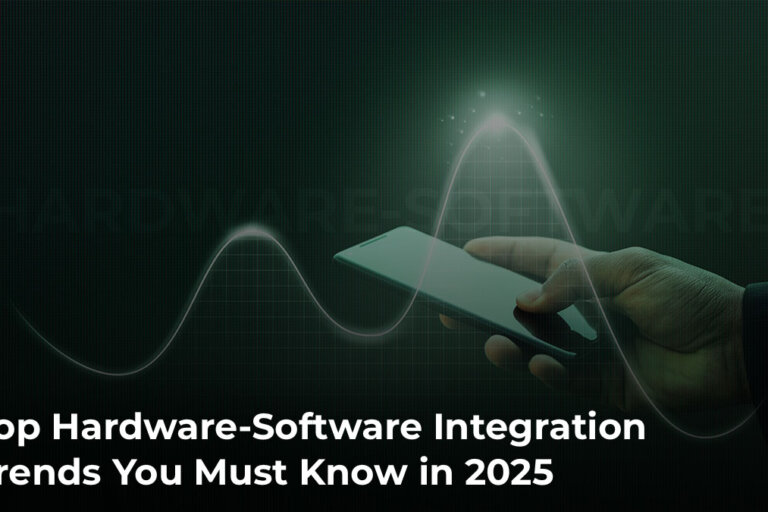7 Essential Stages of Enterprise Software Development in 2025

Enterprise-grade software or apps have progressed to the point where nearly all organizations and businesses depend on them to stay competitive in the marketplace. They’ve become the engine behind modern business operations.
It doesn’t matter if you’re a nonprofit that needs to keep track of donor activities or an auto dealership looking for better inventory management. Mobile enterprise apps offer an unprecedented amount of flexibility and functionality for companies to stay ahead in the years to come.
This post will explore the 7 essential stages in the enterprise software design and development process. If you’re planning to invest in enterprise technology, this guide will give you a clear, practical starting point.
What is Enterprise Software?

Enterprise software or enterprise software application is a powerful computer program that is designed to make business operations smoother, smarter, and more efficient. It employs sophisticated technologies to help businesses access a complete solution that manages everything from day-to-day operations to large-scale processes.
With enterprise software, organizations can build multi-functional applications tailored to their unique requirements. Whether it’s managing mission-critical operations, ensuring seamless collaboration, or scaling resources up and down with business growth, enterprise software makes things easier.
With the pace of technological advancements and breakthroughs happening across industries, having smart tools to simplify business operations has become essential. With the right enterprise application, businesses can handle everyday operational challenges, stay competitive, improve performance, and grow sustainably. Whether you’re a startup, mid-size company, or a large enterprise, there’s an enterprise solution that can fit your unique needs.
Types of Enterprise Software
Let’s look at some popular enterprise software that’s making a real difference in how businesses work:
Customer Relationship Management (CRM):
CRM is an enterprise software system that is widely popular for its high-end capabilities in managing and enhancing customer experiences. It brings all your customer data into one place and makes it easier to understand who your customers are and what they need. They centralize customer data, offer actionable insights for marketing and sales strategies, and support lead generation, cross-selling, and pipeline optimization.
Some advanced CRMs go beyond basic contact management. They can track customer interactions across multiple channels (including social media), provide real-time updates on project statuses, and automate workflows. This kind of insight makes it easier to personalize communication, close more deals, and deliver better customer experiences.
Enterprise Resource Planning (ERP):
ERP is a powerful business management tool that helps companies bring all their core operations and functions into one unified system. Whether it’s deployed on-premise, in the cloud, or through a hybrid setup, ERP systems come packed with built-in intelligence, real-time data access, and even advanced features like machine learning to support better decision-making.
ERP isn’t a one-size-fits-all solution. It adapts to your business needs. Depending on what you’re looking for, it can include modules for managing projects, finances, accounting, HR, supply chains, risk management, customer relationships, forecasting, and more.
One of the biggest strengths of ERP is how it ties together different departments and processes without letting data get lost or isolated. So, instead of juggling with disconnected tools and scattered data, your teams work from a single, reliable source of information. This means fewer silos, fewer mistakes, and a whole lot more efficiency.
Enterprise HR Software
Managing the workforce manually, especially in a growing or large-scale organization, can quickly become overwhelming. That’s why more businesses today rely on enterprise HR software to handle the many moving parts of human resources.
For instance, imagine an HR team trying to manage leave requests using spreadsheets and emails. Approvals get missed, balances aren’t updated on time, and team leaders are often unaware of who’s on leave until the last minute. Now compare that with an enterprise HR system, where employees can apply for leave through a self-service portal, approvals are routed automatically, balances update in real time, and managers can view team availability at a glance. There’s no confusion, no delays.
From maintaining employee records and handling recruitment to managing payroll, leave, attendance, and compliance, HR software takes care of it all in one place. It helps reduce repetitive admin work, eliminates errors, and ensures that nothing slips through the cracks.
With today’s modern Human Resource Management System (HRMS), HR teams can operate more efficiently and focus on what really matters. Also, it gives HR professionals full visibility into the workforce. This means better planning, faster decision-making, and greater compliance with company policies and labor regulations.
Enterprise Business Intelligence (BI)
Enterprise BI systems help businesses bring all their data from different teams, tools, and systems into one unified platform. With interactive dashboards and real-time updates, these platforms make it easier to see what’s really going on across the organization. Whether it’s spotting trends, tracking performance, or catching inconsistencies, BI tools turn raw data into insights for you to act on quickly and confidently.
What makes modern BI even more powerful is the use of AI and natural language processing (NLP). You don’t need to dig through spreadsheets or write complex queries anymore. You can simply ask the system things like “Why have sales dropped this month?” or “Which products have the highest return rates?” and get instant answers in the form of clear reports and visualizations.
For example, say you’re noticing a dip in revenue. A BI tool can help you trace it back to a specific product that’s suddenly seeing more returns than usual. Or maybe it shows you that a particular campaign is bringing in repeat customers for one product line. These insights let you respond faster, adjust your marketing strategies, talk to your suppliers, or tweak your pricing before it starts affecting your bottom line.
Instead of making decisions based on gut feeling, BI ensures your strategies are backed by real, up-to-date data.
7 Key Stages in Enterprise Software Development
Building enterprise software is a strategic process that calls for thoughtful planning, strategy and deep technical expertise. At the core, it’s all about developing solutions that are reliable, scalable, and aligned with your organization’s goals.
At Zco, our development team follows a proven 7-stage approach designed to create robust software that can grow with your business.
But before we walk you through the enterprise software development process, here are a few essential elements every developer should consider upfront:
Scalability – The enterprise system should support future growth, whether that’s more users, new features, or increased data volume.
Usability – A powerful system is only effective if people can use it easily. The user experience needs to be intuitive and efficient.
Secure and Reliable Data Exchange – Strong communication protocols and airtight security ensure your data moves safely across systems.
Seamless Integration – Your enterprise software should work effortlessly with existing tools, platforms, and infrastructure.
Real-Time Reporting – Access to accurate, real-time data helps drive quicker, smarter business decisions.
The Enterprise App Development Process
1. Identify Your Company Needs & Current Capabilities
When developing enterprise software, understanding your business needs and existing IT capabilities is essential. This foundation ensures that the final solution is not only viable but also supports long-term success.
If you haven’t already, consider answering the following questions before doing further research:
- What is the primary goal of the app?
- Do I have a complete list of requirements?
- Is there additional integration with other existing systems?
- Who is the end-user of the application(s)?
- What platform(s) should it support?
Thoroughly vetting these questions upfront will help your company with the process of choosing the right software development company. With a complete understanding of your project scope and end goals, experienced enterprise app developers will be able to add insight and help identify alternatives to strengthen your solution.
Imagine you’re a regional wholesale food distributor.
Your company wants to develop an enterprise app that allows customers to interface directly with your sales team, process orders, and track the status of previous orders. Having noticed many competitors in the market starting to adopt custom software to handle similar situations, your company is looking to develop a competitive app that will give your customers unique and enhanced functions to simplify their day-to-day tasks.
Recognizing that your internal team lacks the bandwidth or technical expertise for such a project, you decide that outsourcing is the most viable path forward. Partnering with the right software development company can bring significant value to your business. They won’t just fill the gaps; they’ll bring deep technical know-how, streamline the process, and accelerate your time-to-market. With clear communication and full transparency, they’ll handle the heavy lifting while keeping you actively involved every step of the way.
When considering your options, look for the following qualities in the development company:
- Experience in Enterprise Software Development
- Project Familiarity
- Established Estimation and Design Process
- Agile Development Approach
- Fine-tuned QA & Testing Process
- Post-launch Support Services
2. Development Methods
There are multiple approaches that companies take when it comes to enterprise software development. The best fit depends on your project’s technical requirements, architectural preferences, and long-term business goals.
Before choosing a development method, evaluate the pros and cons of commonly used models such as Agile, Scrum, Lean, or even Waterfall. Each supports varying degrees of flexibility, speed, and process control. This choice significantly impacts not only your development timeline but also cost estimation, stakeholder involvement, and the overall working relationship with your development team.
Another important factor is your existing enterprise infrastructure. Assess whether any legacy system modules can be reused in the new build. If integration is possible, it can save development time, reduce costs, and simplify workflows — but only if the legacy code is compatible and scalable.
Let’s say your company has assigned a dedicated in-house project manager or VP to oversee the development project. They are required to report status updates to other key individuals.
We design software to reduce the effort of maintenance, but the whole reason we expend effort or make software in the first place is to help people. So it’s okay to spend more effort to help more people. Design is just about removing unnecessary barriers to helping people.
– Max Kanat-Alexander, Author of Code Simplicity
If you’re working with developers who follow an agile software development approach, they would allow your company to develop the app in iterations with weekly or monthly updates based on pre-determined milestones.
This method supports a collaborative workflow with frequent check-ins, status updates, and room for real-time feedback. It’s particularly useful when internal stakeholders expect regular visibility into project progress. Agile also empowers your in-house lead to provide clear, consistent updates to leadership or cross-functional teams.
3. UI/UX Documentation
UI/UX design documentation is one of the most important steps in the enterprise app development process. Your company has decided that the user interface doesn’t need to be a flashy affair, forgoing transition animations and extensive visual elements. Instead, you’re opting for a clean interface that emphasizes efficiency while being easy to use for customers and employees.
Even with a minimalist design approach, take the time to put together user flows and wireframes illustrating the core functions of the app. Having this documentation ready before engaging with external developers will help you communicate key requirements clearly and explore better alternative solutions early in the process.

Beyond functionality, thoughtful UI/UX documentation plays a key role in reinforcing your brand identity. Consistent use of colors, typography, layout, and tone all contribute to a cohesive brand experience across every screen. It also allows you to incorporate accessibility considerations from the start, ensuring that the app is usable for a wider range of users, including those with disabilities.
Having everything clearly documented also enables more accurate cost and timeline estimates. This way, both you and the app development team are on the same page on what’s being built and what it will cost. The timeline for development deliverables will also become clear.
4. Platform Choice
Selecting the appropriate platform, whether it’s iOS, Android, or web is a critical decision that can directly impact the success of your enterprise application. It influences everything from how users interact with your application and the level of device integration possible to development costs and the long-term scalability of your solution.
To make an informed decision, consider these critical factors:
- Hardware Functionality – What device capabilities does the software need to leverage?
- Target Audience and Reach – Who are your users, and what platforms or devices are they already using?
- Cost and Time-to-Market – How quickly do you need to launch, and what’s your budget?
- Ease of Maintenance – How easy will it be to maintain and scale the app over time?
For instance, let’s assume that your Food Distribution company wants to enable its employees and customers to run your app on their iOS devices.
By choosing native iOS development, your enterprise app gains a range of powerful advantages:
- Your company can leverage Apple’s built-in automation, like Siri Shortcuts or Focus modes to streamline repeat behaviors, enhance connectivity and user productivity.
- Swift-based iOS apps benefit from Apple’s strong security frameworks and high-performance architecture, ensuring smooth operation even under demanding conditions.
- Writing native software for iOS hardware allows the app to access the device’s hardware at a low level, enabling deeper integration. It can tap into the iPhone’s or iPad’s built-in capabilities for scanning, location tracking, and real-time connectivity to significantly expand the software functionalities.
- iOS also provides unique capabilities for scalability. This will help create greater integration across the companies’ entire digital ecosystem. Thereby, becoming a functional and accessible component of an employee’s toolkit across multiple iOS devices.
- Native apps run more efficiently and faster than their hybrid and web-based counterparts. Utilizing the Swift programming language, native iOS development allows the app to access core hardware and software components for enhanced functions, security, and performance.
By choosing the right platform and developing natively when appropriate, your app becomes an integrated, reliable, and high-performance asset that enhances how your team works and how your customers interact with your brand. Platform decisions made at this stage will continue to influence everything from user satisfaction to development costs and update cycles down the line.
5. Hardware Integration
In many enterprise environments, especially in logistics, retail, healthcare, or manufacturing, hardware integration isn’t just a nice-to-have feature; it’s a core requirement for operational efficiency.
One common request from enterprise clients is the ability to integrate physical hardware, such as smart-device barcode scanners, directly into the enterprise software. This allows users (employees or customers) to scan barcodes to instantly check inventory, reorder products, or track items—all from within the enterprise app.
Hardware integration enables automation, improves accuracy, and significantly speeds up routine tasks, particularly in environments where speed and precision are critical. Without it, employees might be stuck manually entering data, increasing the risk of errors and delays.

Beyond functionality, thoughtful UI/UX documentation plays a key role in reinforcing your brand identity. Consistent use of colors, typography, layout, and tone all contribute to a cohesive brand experience across every screen. It also allows you to incorporate accessibility considerations from the start, ensuring that the app is usable for a wider range of users, including those with disabilities.
Having everything clearly documented also enables more accurate cost and timeline estimates. This way, both you and the app development team are on the same page on what’s being built and what it will cost. The timeline for development deliverables will also become clear.
6. Backend Functionality
When thinking about app development, back-end functionality is often one of the most overlooked components. While the front-end of the product may be what the users see and interact with, it’s the backend that powers essential business logic, data handling, and system communication.
For enterprise applications, a robust, well-architected backend is non-negotiable. It’s responsible for critical operations like order processing, inventory management, user roles and permissions, billing workflows, and seamless data flow between systems. Without it, the app won’t scale reliably or meet the demands of complex business-critical workflows.
Take, for example, a backend that powers order fulfillment:
It needs to receive new client orders, track them through sales and delivery, and keep every stakeholder (from sales to logistics) aligned in real time. If your enterprise already has a server infrastructure and databases in place for this, it makes sense to leverage that existing system rather than building a new one from scratch.
Through custom APIs and middleware connectors, the app can interface directly with your legacy systems, enabling real-time data synchronization between the new application and your existing backend. While additional requirements may be needed, having a system in place may help shorten development time, as a back-end system does not need to be built from scratch to support data management.
This not only shortens development time but also helps maintain data integrity across various departments, ensuring everyone references the same source of truth.
Here are the benefits of leveraging an existing backend:
- Faster development and reduced costs.
- Minimized duplication of effort.
- Improved decision-making with real-time, shared data.
- Reduced risk of data mismatches across departments.
That said, if no backend infrastructure exists, it’s equally important to invest in backend planning early in the process. This includes defining architecture (monolith vs. microservices), choosing the right database (SQL/NoSQL), designing secure APIs, and incorporating tools for authentication, caching, and scalability.
With no backend infrastructure, it’s also wise to choose cloud platforms or Backend-as-a-Service (BaaS) offerings to speed up development and reduce overhead. Services like Firebase, AWS Amplify, or Azure App Services can help bootstrap features like authentication, databases, and hosting quickly.
Whether you’re extending an existing backend or starting from scratch, backend planning is the cornerstone of your enterprise software success.
7. Active Development
Because of the extensive planning that went into the design document, your ideal enterprise software development partner can now transition smoothly into active development.
This stage is the core execution phase of your enterprise software development, which is typically organized into sprints or milestone-based cycles, depending on whether the team follows an Agile or hybrid methodology. Each sprint focuses on building and delivering specific features, allowing for incremental progress that’s visible and measurable. Regular check-ins, demos, and progress reports keep your internal stakeholders involved and provide ample opportunity for feedback and course correction when needed.

Besides, rigorous quality assurance (QA) testing is performed continuously to catch bugs early and ensure the enterprise software performs reliably under real-world conditions.
Once development and testing are complete, the app is either deployed internally (for private enterprise use) or released via public distribution channels like the App Store or Google Play, depending on the intended audience.
The result? A robust, high-performing enterprise application that not only meets your functional requirements but also unlocks new efficiencies, insights, and opportunities for business transformation.
Build a Scalable Enterprise App For Your Business
Designing and implementing a successful enterprise app hinges on creating a detailed plan around your needs and working with knowledgeable, experienced developers. Whether you’re battling fragmented systems, slow processes, or siloed data, the right enterprise app can bring a transformative impact on how your business operates at its core.
At Zco Corporation, we don’t take a one-size-fits-all approach. We collaborate closely with your team to understand your systems, challenges, and goals, and then architect enterprise-grade software that brings immediate value and long-term resilience.
We’ve delivered custom enterprise solutions for data-intensive platforms, real-time operational tools, and mission-critical workflows across industries, all with measurable outcomes and clean execution. Our process is transparent, our teams are technically fluent, and our builds are designed for longevity.
If you’re looking for an enterprise software development partner who brings technical depth, business sense, and execution you can rely on, let’s talk.
Get in touch today for a strategic consultation.












